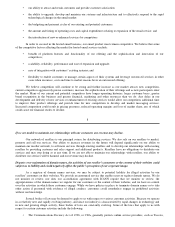Tucows 2013 Annual Report Download - page 21
Download and view the complete annual report
Please find page 21 of the 2013 Tucows annual report below. You can navigate through the pages in the report by either clicking on the pages listed below, or by using the keyword search tool below to find specific information within the annual report.
•
the number and significance of service enhancements and new service and technology announcements by our
competitors;
•
our ability to identify, develop, deliver and introduce in a timely manner new and enhanced versions of our current
service offerings that anticipate market demand and address customer needs;
•
changes in foreign currency exchange rates and issues relating to the conversion to the Canadian dollar;
•
foreign, federal or state regulation affecting our business;
•
our ability to continue to attract users to our website;
•
our ability to attract software developers to participate in our Author Resource Center;
•
our ability to continue to attract advertisers to place content on our website;
•
technical difficulties or other factors that result in system downtime;
•
seasonality of the markets and businesses of our customers;
•
news relating to our industry as a whole;
•
our ability to enforce our intellectual property rights;
•
our ability to manage Internet fraud and information theft; and
•
current economic conditions.
Our operating expenses may increase. We base our operating expense budgets on expected revenue trends that are
more difficult to predict in periods of economic uncertainty. We intend to continue our efforts to control discretionary
spending; however, we will continue to selectively incur expenditures in areas that we believe will strengthen our position in
the marketplace. If we do not meet revenue goals, we may not be able to meet reduced operating expense levels and our
operating results will suffer. It is possible that in one or more future quarters, our operating results may be below our
expectations and the expectations of public market analysts and investors. In that event, the price of our common stock may
fall.
Ting has a short operating history which may not be indicative of our future performance and, if our revenue and
earnings growth are not sustainable, we may not be able to generate the earnings necessary to fund our operations or
continue to grow our business.
We launched Ting nationally in February 2012 and had no revenues before that time. Consequently, Ting has a
limited operating and financial history upon which to evaluate its business model, financial performance and ability to
succeed in the future. You should consider its prospects in light of the risks it may encounter, including risks and expenses
faced by a new business competing in rapidly evolving and highly competitive markets. Ting cannot be certain that its
Mobile Virtual Network Operator (“MVNO”) business model or any specific products or services will be profitable or
competitive in the long-term against larger, facilities-based wireless providers or other MVNOs. Ting also cannot predict
whether its MVNO model will allow it to offer the wireless services that customers may demand in the future. If Ting is
unable to achieve sufficient revenues and earnings from operations, its financial results will be adversely affected and it may
not have sufficient cash to fund its current operations or sustain its continued growth.
19
Ting’s service offerings may not be successful in the long term.
Ting services may not prove to be successful or profitable in the long term. Ting’s long-term success is dependent
upon its sustained ability to generate sufficient revenue from its subscribers based on their use of its services and its ability to
respond to churn by adding new customers. If Ting is unable to sustain or increase the revenue that it generates from its
existing customers or obtain new customers to replace churned customers, its operational performance and financial results
may be adversely affected.
























